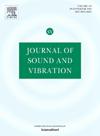On introducing conicity in tubular origami metastructures for programming the nonlinear dynamics in an expanded design space
IF 4.3
2区 工程技术
Q1 ACOUSTICS
引用次数: 0
Abstract
Kresling origami-based metamaterials have gained significant attention lately due to their mechanical advantages like deployability, energy manipulation and absorption, vibration control and tailorable constitutive behavior. While previous investigations have primarily focused on kinematics and statics, as most engineering applications experience dynamic conditions, few recent studies have examined the dynamic performance including transient and linear vibration. In this paper, we computationally investigate the nonlinear dynamics of Kresling origami in an expanded design space through the introduction of conical architecture. The conical Kresling origami module (CKOM) leads to a highly nonlinear behavior, originating from the geometrical constraints. This makes the dynamic behavior under specific natures of external disturbance more complex and chaotic, while programmable as a function of the geometrical features. CKOM provides an excellent support system and better stability at period-n attractor, which means that the system behaves in the same pattern after n-period of oscillation. It is further noted that the CKOM system is an elastically foldable truss-like idealized structure, which often exhibits interesting static behavior like bi-stability. Programmability in the expanded design space of conicity and other geometrical parametric features of the Kresling tubular origami would lead to widespread applications including spacecraft, aircraft wings, robotics, vehicles, and various deployable structures across the length scales.
求助全文
约1分钟内获得全文
求助全文
来源期刊

Journal of Sound and Vibration
工程技术-工程:机械
CiteScore
9.10
自引率
10.60%
发文量
551
审稿时长
69 days
期刊介绍:
The Journal of Sound and Vibration (JSV) is an independent journal devoted to the prompt publication of original papers, both theoretical and experimental, that provide new information on any aspect of sound or vibration. There is an emphasis on fundamental work that has potential for practical application.
JSV was founded and operates on the premise that the subject of sound and vibration requires a journal that publishes papers of a high technical standard across the various subdisciplines, thus facilitating awareness of techniques and discoveries in one area that may be applicable in others.
 求助内容:
求助内容: 应助结果提醒方式:
应助结果提醒方式:


